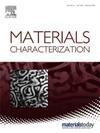Ablation behavior of (Ti0.2Zr0.2Hf0.2Nb0.2Ta0.2)B2-SiC-Si ceramics via reactive melt infiltration
IF 4.8
2区 材料科学
Q1 MATERIALS SCIENCE, CHARACTERIZATION & TESTING
引用次数: 0
Abstract
(Ti0.2Zr0.2Hf0.2Nb0.2Ta0.2)B2-SiC ceramics with an open porosity of only 0.49 % were successfully fabricated in this work by the reactive melt infiltration (RMI) method. Air plasma flame ablation behavior of (Ti0.2Zr0.2Hf0.2Nb0.2Ta0.2)B2-SiC ceramics under 2300 °C temperature exhibited excellent resistance with mass and linear ablation rates of 3.66 mg/s and 0.88 μm/s, respectively. During ablation, the transition from continuous melting sublimation of Si and oxidation of SiC to oxidation of (Ti0.2Zr0.2Hf0.2Nb0.2Ta0.2)B2 occurred. The uphill diffusion of Ti atoms transited (Ti,Zr,Hf,Nb,Ta)Ox to Ti(NbxTa1-x)2O7 while Zr0.5Hf0.5O2 continuously precipitated. A multicomponent oxide layer of (Ti,Zr,Hf,Nb,Ta)Ox along with (Zr,Hf)6Ta2O17, (Hf,Zr)(TiO4)2, and (Zr,Hf)x(Ti,Ta)1-xO embedded in SiO2 melt was eventually formed on the ceramic surface. This oxide layer was spread above the high melting point Zr0.5Hf0.5O2, Ti(NbxTa1-x)2O, and low oxygen content (Ti,Zr,Hf,Nb,Ta)Ox to form a stable, dense, and high viscosity protective layer.
通过反应熔体渗入实现的(Ti0.2Zr0.2Hf0.2Nb0.2Ta0.2)B2-SiC-Si 陶瓷的烧蚀行为
(本研究采用反应熔渗(RMI)方法成功制备了开孔率仅为 0.49 % 的(Ti0.2Zr0.2Hf0.2Nb0.2Ta0.2)B2-SiC 陶瓷。在 2300 °C 温度下,(Ti0.2Zr0.2Hf0.2Nb0.2Ta0.2)B2-SiC 陶瓷的空气等离子体火焰烧蚀行为表现出优异的抗性,其质量烧蚀率和线性烧蚀率分别为 3.66 mg/s 和 0.88 μm/s。在烧蚀过程中,发生了从硅的连续熔融升华和碳化硅的氧化到(Ti0.2Zr0.2Hf0.2Nb0.2Ta0.2)B2 氧化的转变。钛原子的上坡扩散将(Ti,Zr,Hf,Nb,Ta)Ox 转变为 Ti(NbxTa1-x)2O7,同时 Zr0.5Hf0.5O2 不断析出。最终在陶瓷表面形成了(Ti,Zr,Hf,Nb,Ta)Ox以及(Zr,Hf)6Ta2O17、(Hf,Zr)(TiO4)2和嵌入二氧化硅熔体的(Zr,Hf)x(Ti,Ta)1-xO的多组分氧化层。这层氧化物分布在高熔点 Zr0.5Hf0.5O2、Ti(NbxTa1-x)2O 和低氧含量 (Ti,Zr,Hf,Nb,Ta)Ox 的上方,形成了稳定、致密和高粘度的保护层。
本文章由计算机程序翻译,如有差异,请以英文原文为准。
求助全文
约1分钟内获得全文
求助全文
来源期刊

Materials Characterization
工程技术-材料科学:表征与测试
CiteScore
7.60
自引率
8.50%
发文量
746
审稿时长
36 days
期刊介绍:
Materials Characterization features original articles and state-of-the-art reviews on theoretical and practical aspects of the structure and behaviour of materials.
The Journal focuses on all characterization techniques, including all forms of microscopy (light, electron, acoustic, etc.,) and analysis (especially microanalysis and surface analytical techniques). Developments in both this wide range of techniques and their application to the quantification of the microstructure of materials are essential facets of the Journal.
The Journal provides the Materials Scientist/Engineer with up-to-date information on many types of materials with an underlying theme of explaining the behavior of materials using novel approaches. Materials covered by the journal include:
Metals & Alloys
Ceramics
Nanomaterials
Biomedical materials
Optical materials
Composites
Natural Materials.
 求助内容:
求助内容: 应助结果提醒方式:
应助结果提醒方式:


